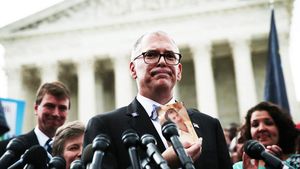
Treatment GuideJust DiagnosedSex & DatingAfrican AmericanStigmaAsk the HIV DocPrEP En EspañolNewsVoicesPrint IssueVideoOut 100
CONTACTCAREER OPPORTUNITIESADVERTISE WITH USPRIVACY POLICYPRIVACY PREFERENCESTERMS OF USELEGAL NOTICE
© 2025 Pride Publishing Inc.
All Rights reserved
All Rights reserved
By continuing to use our site, you agree to our Privacy Policy and Terms of Use.
'But ya are, Blanche, ya are!'
'Bette Davis in What Ever Happened to Baby Jane?
The mayor and some of the residents of Quincy, Fla., are pissed off at Essence magazine. In the February issue, Essence, the preeminent fashion and lifestyle magazine for African-American women, published a feature story profiling a local doctor, a community leader, and some town residents. One would think that a small town like Quincy would welcome the 'celebrity' brought by a big-time magazine. Quincy is not Miami, with the glitz and glamour of South Beach, or Orlando, with the 'the happiest place on the earth' as a neighbor. Quincy is a sleepy small town on the northern edge of the Florida panhandle and has a relatively huge AIDS problem. Essence reported that 130 of Quincy's 7,500 residents have been infected with HIV. According to Essence, 90% of those infected in Quincy are African-Americans; the majority of these are women.
The mayor feels that Essence unfairly 'picked on' his town. He says the AIDS epidemic is no worse in Quincy than in other small towns in Florida. He's angry because he feels the article will damage Quincy's image.
'The lady doth protest too much, methinks.'
'From William Shakespeare's Hamlet
AIDS activists around the country are up in arms over a story written by Gregory A. Freeman in Rolling Stone magazine. The story profiles a young gay man living in New York. 'Carlos,' as he is called in the article, is described as tall and attractive with 'longish, curly-wavy' jet-black hair with golden highlights. According to Freeman, Carlos is funny and has a 'very appealing smile and laugh.' The description makes one think that Carlos would be quite a catch. But Carlos, as the article explains, is not trying to get 'caught.' He's trying to catch something'HIV.
AIDS activists have called the story 'sensationalistic.' They are concerned that the story implies that a large number of men who have sex with men are deliberately spreading HIV and that this will make people unsympathetic to the fight against HIV, increase homophobia, and make it more difficult to get funding for AIDS organizations.
I've read both stories. The Essence story is beautifully written by Kristal Brent Zook and photographed by Michelle Agins. It tells the story of a small town with a big problem'poverty, drug abuse, poor education, an inferior health care system, and AIDS. It tells a story about how even in the face of such hardships people can and do come together to try to make a difference.
The Rolling Stone article is a little sensationalistic. Some of the people quoted in the article say they were misquoted or their quotes were used out of context, and Freeman did get one of the most important stats in his story wrong. He reports that an estimated 25% of all newly infected gay men are infected through 'bug chasing.' According to the Rolling Stone article, based on 40,000 new infections a year in the United States, that would mean around 10,000 new infections a year are attributable to bug chasing. What Freeman misses is that those 40,000 new cases are not all gay men. Only 42% of new infections annually are among men who have sex with men; 33% are through heterosexual sex, and 25% from injection-drug use. So even if one concedes that at least 25% of the new infections among gay and bisexual men are the result of bug chasing (and there is no data to suggest this is accurate), there is no way that the 10,000 figure is correct or even close.
What struck me about both of these stories is how critical players in the fight against HIV are so off the mark. The mayor of Quincy is right. Sadly, Quincy is not unique among small Southern rural towns. There is a raging epidemic going on in rural America.
I agree with AIDS activists who say there is no evidence to suggest that bug chasing is a major contributor to the spread of HIV. And that's part of the problem. There's no evidence one way or another. We just don't know. There is evidence to point to the role of fatalism, depression, and hopelessness'all characteristics described in the Rolling Stone article'within HIV prevention efforts. Whether bug chasing is a big phenomenon or a tiny fetish, we have a responsibility to know the magnitude of the behavior and to try to develop interventions to address the problem.
HIV carries a tremendous amount of stigma. Part of the job description for the mayor of Quincy is to attract people and businesses to Quincy. And image is important. But it seems to me that the first responsibility of a mayor is to protect the citizens of his town, and Quincy is under attack by a vicious invader.
It is legitimate for AIDS activists to be concerned about how the general public will react to the news that there are some gay men'no matter how few'who are intentionally getting infected and knowingly infecting others. But our first and primary obligation is to stop the spread of HIV. That requires us to look at the ugly and hard questions before us. AIDS is being spread in small towns all over America, and there are people who are bug chasers. That much is clear. We all need to be less concerned about image and funding and more concerned about creating a world without AIDS.
Wilson is director of the African-American HIV University, a two-year fellowship program, and founding director of the Black AIDS Institute.
From our Sponsors
Most Popular
BREAKING: Supreme Court rules to save free access to preventive care, including PrEP
June 27 2025 10:32 AM
Thanks to U=U, HIV-positive people can live long, happy, healthy lives
July 25 2025 2:37 PM
The Talk: Beyond the exam room
August 13 2025 3:15 PM
Plus: Featured Video
Latest Stories
Amazing People of 2025: Javier Muñoz
October 17 2025 7:35 PM
It’s National PrEP Day! Learn the latest about HIV prevention
October 10 2025 9:00 AM
“I am the steward of my ship”: John Gibson rewrites his HIV narrative
September 16 2025 2:56 PM
“So much life to live”: Eric Nieves on thriving with HIV
September 03 2025 11:37 AM
The Talk: Owning your voice
August 25 2025 8:16 PM
The lab coat just got queer
August 21 2025 10:00 AM
Messenger RNA could be the key to an HIV vaccine — but government cuts pose a threat
August 20 2025 8:02 AM
The Talk: Navigating your treatment
August 01 2025 6:02 PM
The Talk: Starting the conversation
July 25 2025 4:47 PM
How the Black AIDS Institute continues to fill in the gaps
July 25 2025 1:06 PM
“I felt like a butterfly”: Niko Flowers on reclaiming life with HIV
July 23 2025 12:22 PM
Dancer. Healer. Survivor. DéShaun Armbrister is all of the above
July 02 2025 8:23 PM
1985: the year the AIDS crisis finally broke through the silence
June 26 2025 11:24 AM
VIDEO: A man living with HIV discusses his journey to fatherhood
June 10 2025 4:58 PM
Trump admin guts $258 million in funding for HIV vaccine research
June 03 2025 3:47 PM
Grindr is reminding us why jockstraps are so sexy and iconic
May 02 2025 5:36 PM
HRC holds 'die-in' to protest Trump health care cuts
April 28 2025 2:11 PM
Two right-wing Supreme Court justices signal they may uphold access to PrEP and more
April 21 2025 4:10 PM


































































